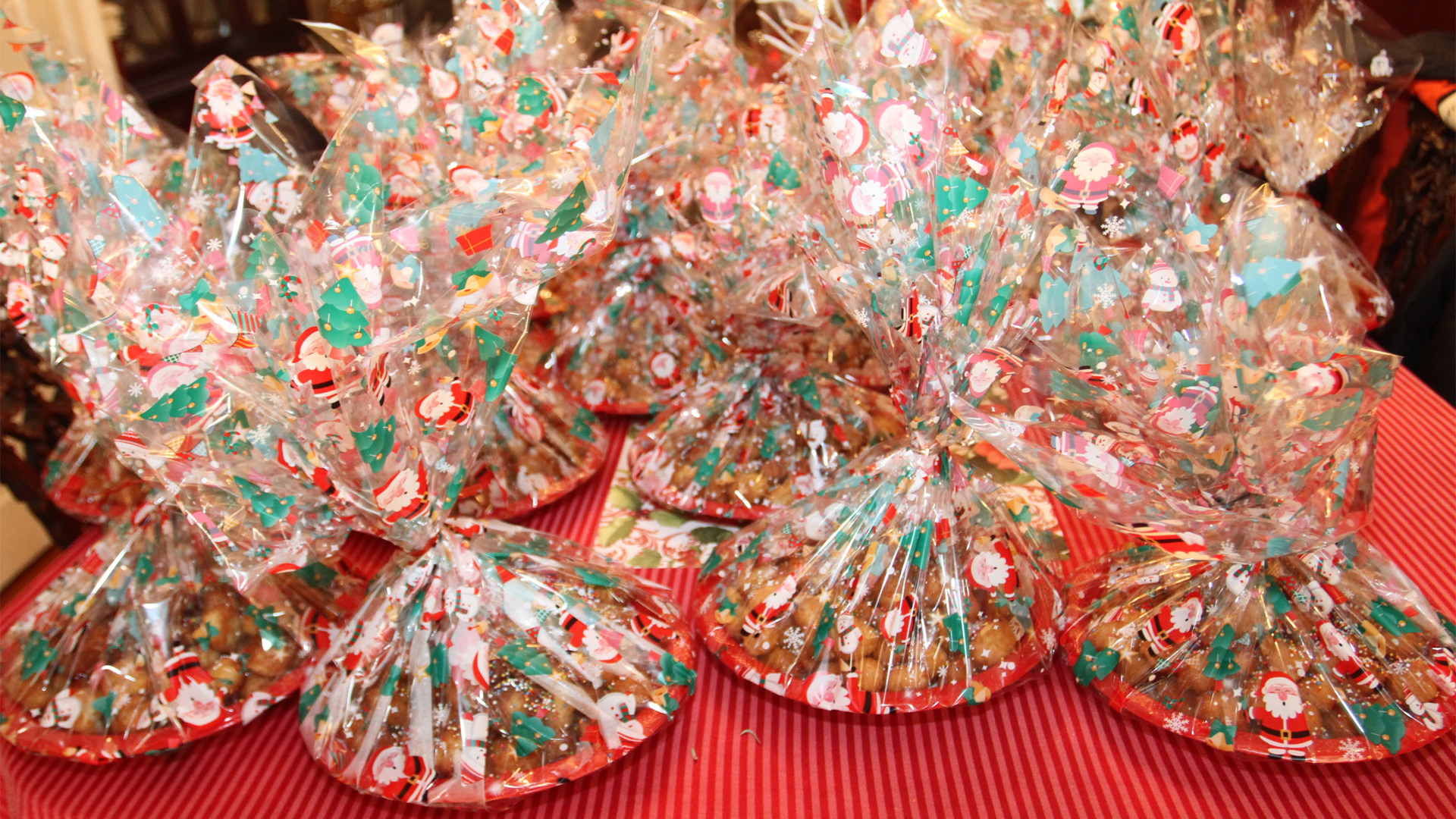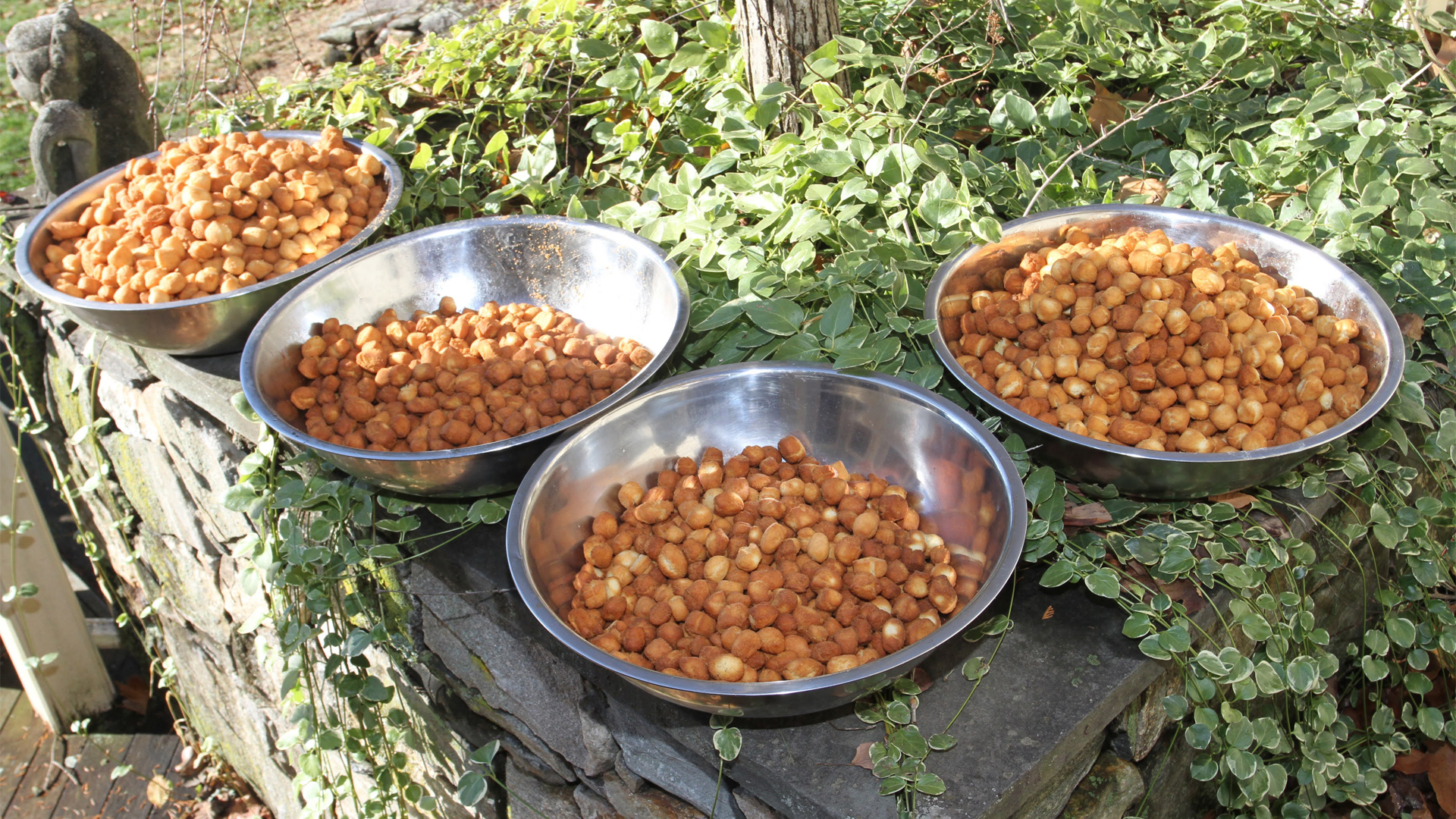Neapolitan Struffoli are typically the size of marbles made from leavened dough with eggs and butter. They are flavored with citrus zest, and sometimes anise flavored liqueur. Then the dough balls are deep fried before covered with a warm syrup made from honey.
Christmas is the perfect time to serve up a tray of struffoli, and fried pastry balls covered in honey and topped with candies, sprinkles, and fruits. They arrived in the United States with immigrants from Southern Italy, but there's more to the story of these sticky sweets.

(Photo Courtesy of Al DiGuido)
The honey helps preserve the pastry dough once it has been cooked, but helps mold the balls into shapes. They are often piled into tall cones, shaped into wreaths, or simply mounded in a pile. The honey also holds the other toppings in place.
In Naples, holiday guests frequently bring along a tray of struffoli as a gift for their host. The dessert is served at the beginning of Christmas through the Epiphany on January 6th. Struffoli became a Christmas tradition in Medieval Naples because convents would bake the treat to give away to families who had shown extraordinary piety or good works during the year. Making struffoli was a laborious process undertaken by the nuns, and the verb "strofinare," meaning to rub, might be where the term "struffoli" originated from. The rubbing creates the signature ball shapes.
Outside of Naples, similar honey-glazed dough desserts are served at other holidays throughout the year and topped with the same fruit and candy, but go by other names. In Abruzzo, a dessert known as cicerchiata are formed into a wreath shape and served during Carnevale. The name comes from the Cicerchia Bean, a bean similar to chickpeas with a tooth-like shape. There, the honey-dipped balls are topped with sliced nuts, sprinkles, and candied fruit.

(Photo Courtesy of Al DiGuido)
Calabria has several varieties. Cicerata, also named because of the similar size to chickpeas, may include chocolate in the glaze. Scalille are fried in the shape of dog bones, and larger pieces in lattice or braided shapes. Turdilli, a nugget-shape dough, is not always covered in honey, while pignolata are more or less identical to struffoli. Sicilians also call them pignolata, a term that in Sicilian dialect means "pine nut."
In Puglia and Basilicata, they are known as purceddhruzzi, meaning "little pigs." Some versions of these include orange or other citrus juices to bind the dough instead of eggs.
Despite the many varieties of Italian struffoli, the origins of the dish are much older. Throughout the Mediterranean basin, fried dough and honey has existed for thousands of years.
One of the oldest varieties is a Greek dish known as Loukoumades, a treat dating back to the ancient world. Writing in the third century B.C.E., the Greek Poet Callimachus spoke of "honey tokens" served during the early Olympic Games. The honey tokens honored Coroebus of Elis, a baker and Olympic runner who won the games of 776 B.C.E.

(Photo Courtesy of Al DiGuido)
To make Loukoumades, the batter is squeezed into oil and then covered in lemon, honey, and cinnamon. Unlike Struffoli, Loukoumades are best when they are fresh and warm. However, the Greek influence might also be where Struffoli got their name – from, strongoulos, a Greek term meaning rounded.
Another similar dish in Greece and Turkey is bimuelos or burmuelos, eaten by Jewish families to celebrate Hanukkah. These fritters are more like zeppole than struffoli, but are similarly flavored with honey, and served to celebrate Hanukkah. The holiday commemorates a miracle where the Temple of Jerusalem maintained an oil flame for eight days despite only having enough oil for one night, so fried foods cooked in oil are often included in those traditions.
The Greek Louloumades likely arrived in southern Italy during the Magna Greacia period. This era between the 8th and 5th century B.C.E. was a time when ancient Greek City-States set up colonies along the southern coastline of Italy. It had a lasting impact on the culture and food.
A more recent influence may have come by way of Spain. Served around Easter, the Spanish Tortas de Piñonate is another sticky creation similar to struffoli. Originating in the town of Castillo de las Guardas outside of Seville, Spain, Piñonate is held together by honey syrup similar to struffoli. Flavored with orange zest, the dough is fried into long strips before being cut into small pieces and topped with honey syrup. The sticky dough is then cut into pieces. Ferdinand II of Aragon likely introduced this sweet to Naples in the 16th Century.
Antoni Latini, author of one of the earliest Italian cookbooks, The Modern Steward, Or the Art of Preparing Banquets Well, includes a recipe for what he calls Roman struffoli. This is the same early recipe collection that includes the first tomato sauce recipe in Italy. Latini was a chef in the Kingdom of Naples and his manuscript offers a unique look at the foods of the era, at least on the tables of the wealthy.
Regardless of where struffoli are from, they are usually topped with colorful accessories. Candied fruit is most common, especially bright red and green cherries. Candied fruits have long been part of Italian sweets added to such delicacies as terrone. Another topping more common in Italy than the United States are Slivered almonds while Americans prefer Jordan almonds, the sugar covered "confetti" often tossed at new brides. And finally, most include candy sprinkles of some kind, whether tiny bead-like or classic rainbow sprinkles is a matter of preference. All of these additions add bright colors to the otherwise golden fried dough.

(Photo Courtesy of Al DiGuido)
Historically, struffoli recipes included lard in the dough, but today recipes are more likely to use butter. Other changes have included adding baking soda to help with leavening, and some recipes even call for baking the balls in an oven rather than deep frying them in oil.
Today, Italian Americans generally use the term struffoli interchangeably for the many styles of honey-glazed dough, and bakeries typically sell trays of the treats for Christmas, New Years, and even Easter. Whether you prefer eating the candy pieces or the pastry, your hands will be sticky with honey.


